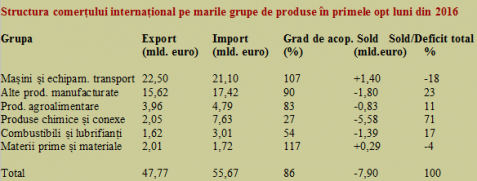 Trade deficit for the first ten months of this year was EUR7,899.8 million, about 23% higher than the same period of last year. The coverage ratio of imports by exports maintained below 90%, level that have been exceeded every year in the period 2013-2015.
Trade deficit for the first ten months of this year was EUR7,899.8 million, about 23% higher than the same period of last year. The coverage ratio of imports by exports maintained below 90%, level that have been exceeded every year in the period 2013-2015.
In the first ten months of 2016, imports grew significantly faster than exports (6.4% against 4.1% in euro), but the difference eased over the past two months.
Noteworthy is the lower growth registered in October compared to the same month of the previous year (only + 3.3% for imports and + 2.0% for exports).
Evolution of the coverage ratio of imports by exports between 2009-2015
Year
Coverage rate FOB/FOB
*
Altogether, the negative monthly balance of foreign trade seems to have stabilized somewhere around EUR1 billion. The exact values for October 2016 were EUR 5,091 million for export and EUR 6,062 million for import, which resulted in a deficit of EUR971 million.
Therefore, the forecasted deficit of 10 billion in 2016 appears as plausible if the trend will maintain in the last two months of the year.
As ratio between the negative balance of foreign trade of goods to the forecasted GDP for the current year, we already have a minus of about 4.6% of GDP, which confirms that the result for 2016 is heading towards minus ten billion euros. That measures the incapacity of local production to adapt to the domestic demand or offset by external deliveries.
Structure of deficit: 90% EU, 10% non-EU
Trade with the EU countries comprised EUR 35.95 billion in exports (75.3% of total exports) and EUR 43.06 billion in import (77.3% of total imports). Almost 90% of the deficit comes from the intra-Community trade, a clear sign of lack of competitiveness compared to the EU countries, which asks for measures to be applied.
In terms of extra-Community trade, exports amounted EUR11.82 billion (24.7% of total exports) and imports EUR 12.61 billion (22.7% of total imports). The negative balance has been strengthening and exceeded 10% of the trade deficit. Previously, in the period 2013-2014, Romania balanced the trade with the non-EU area and even recorded some small surpluses.
*
- Structure of foreign trade in the first 10 months of 2016 (million euros)
- Export Import Surplus/Deficit Share of deficit
- Intra-Community 28 trade
- Extra-Community 28 trade
- Total
*
Export performance of the machinery and transport equipment, cancelled by the consumer goods imports
In the trade structure, about 47% of the Romanian exports are represented by the machinery and transport equipment. This is the only group of products placed in the positive range that compensates by 18% the negative balance of the total trade. This result is cancelled only by the fuels and lubricants segment on which we cannot cover the domestic demand.
In other words, it is not about whatever sophisticated consumer goods that we lack in our production, but the immense volume of certain petrochemical products that we were able to provide, not long ago, which had before 1989 a consistent foreign-exchange contribution and not generated a current account deficit to put pressure on the exchange rate.
*
- Structure of foreign trade by main group of products in the first eight months of 2016
- Group export (billion euros) import (billion euros) Coverage ratio (%) Balance (billion euros) Balance/Total deficit (%)
- Machinery and transport equipment
- Other manufactured products
- Agri-food products
- Chemicals and related products
- Fuels and lubricants
- Raw materials and consumables
- Total
*
The biggest problem occurs with the trade of chemicals and related products, where the massive sectoral deficit moves us towards a chronic negative foreign trade. The total unfavourable rate of 2 to 8 billion euros and says it all about the consequences of the privatization and the price liberalization policies for the energy used in this sector.
Of course, we cannot overlook the overall unfavourable trade of the manufactured goods other than the machinery and transport equipment, which contributed additional nearly two billion to the deficit in the first ten months. Neither the inability to at least balance the imports of food products by exports, rather a proof of the lack of competitiveness of the food industry than of the agriculture.











